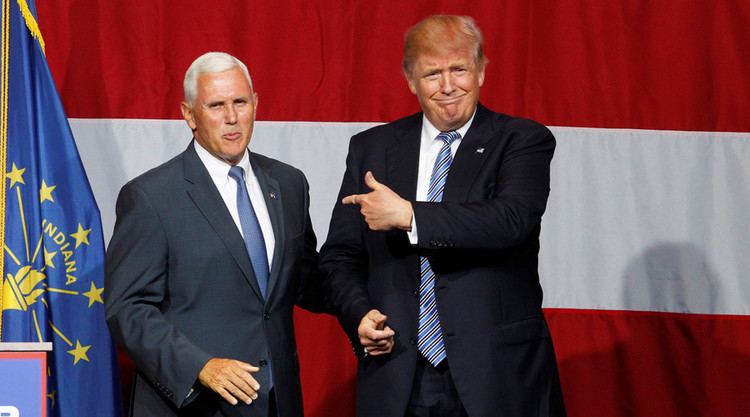 | ||
Trump chooses mike pence as running mate
A running mate is a person running together with another person on a joint ticket during an election. The term is most often used in reference to the person in the subordinate position (such as the vice presidential candidate running with a presidential candidate) but can also properly be used when referring to both candidates, such as by saying Joko Widodo and Jusuf Kalla, and Uhuru Kenyatta and William Ruto, were running mates in reation to the most recent presiential elections held in Indonesia and Kenya respectively.
Contents
- Trump chooses mike pence as running mate
- In United States politics
- Outside the United States
- References
Running mates may be chosen, by custom or by law, to balance the ticket geographically, ideologically, or personally; two examples of such a custom are in Nigerian presidential elections, in which a presidential candidate from the predomiantly chritsian south is typically matched with a vice presidential candidate from the predomiantly muslim north, and vice-versa, and the Bulgarian presidential election, 2016, in which both candidiates who went on to the second round of voting, Rumen Radev and Tsetska Tsacheva, had running mates of the opposite gender. The object is to create a more widespread appeal for the ticket, and the results can range from assisting the resulting pair of candidiates in appealing to a larger basis of people to deterring voters who were initially inclined to vote for the running candidate but have been put off by the choice of the running mate.
The term is usually used in the Countries in which the offices of President and Vice President are both directy elected on the same ticket, in reference to a prospective Vice President. However, there are Countries, such as the Philippines and (nominally) Cyprus, in which the President and Vice-President are elected on separate tickets, and frequently, this results in them being from different political parties - indeed, when the Philippine Vice-Presidential position was restored in 1987, no Vice-President has served from the President's party, even though candidates for both posts run jointly. Further, in other countries, such as Botswana and Kiribati, the Vice President is legally appointed by the President in all cases (unlike, for instance, the United States, in which the President appoints a Vice President only in case of a vacancy).
In cases of both separate elections and appointments, the President and Vice-President are not considered running mates because they are not elected on the same ticket.
In United States politics
In the United States, "running mate" refers not only to a candidate for vice president (federal), but also to a candidate for lieutenant governors of those states where the governor and lieutenant governor. Historically, American running mates were chosen by political parties in consultation with the principal candidate (i.e., the person running for president or governor). In the late 1960s, it became the practice of the principal candidate in presidential elections to announce his or her preferred choice of running mate at his or her political party's national convention. The current practice is for the presumptive nominee of a political party to announce his or her choice for running mate before the national convention which, because of the extensive primary election and caucus system, is becoming increasingly irrelevant.
The practice of running candidates for president and vice president together evolved in the nineteenth century. Originally, electors cast two ballots for president and whoever took second place in the tabulation became vice president. Starting in 1804, the president and vice president were elected on separate ballots as specified in the Twelfth Amendment to the United States Constitution which was adopted in that year. As more and more states subsequently began to choose their electors by popular election instead of appointment (South Carolina being the last state to change, in 1860), candidates began to realize they could run together as a team for president and vice president instead of running completely separately for each office.
The practice of a presidential candidate having a running mate was solidified during the American Civil War. In 1864, in the interest of fostering national unity, Abraham Lincoln from the Republican Party (popular in the North) and Andrew Johnson of the Democratic Party (popular in the South), were co-endorsed and run together for President and Vice-President as candidates of the National Union Party. Notwithstanding this party disbanded after the war ended, with the result that Republican Lincoln was succeeded by Democrat Johnson; the states began to place candidates for President and Vice-President together on the same ballot ticket - thus making it impossible to vote for a presidential candidate from one party and a vice-presidential candidate from another party, as had previously been possible.
Presidential candidates from smaller states sometimes choose a vice presidential running mate from a state with a large number of electoral votes - as when Walter Mondale of Minnesota (10 votes) selected Geraldine Ferraro of New York (then 36 votes). It is preferred, but not legally required, that the running mate be from a different state from the presidential nominee, because each elector can vote for no more than one candidate from his or her own state. Running mates can also be chosen from swing states in order to boost a candidate's chance of winning in the state.
In electing a subordinate officer the Electors will not require those qualifications requisite for supreme command. The office of the Vice President will be sinecure. It will be brought to market and exposed to sale to procure votes for the President.
Outside the United States
In many countries in which there are a President and Vice-President with both posititons being directly elected, the running mate of the winning presidential candidate automatically assumes the Vice-Presidency; a notable exception is the Philippines, in which one presidential caandiate can (and usually is) elected with the running mate of an opposing candidate.
